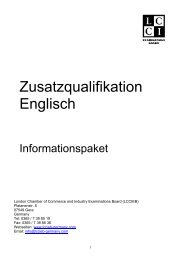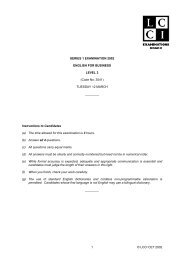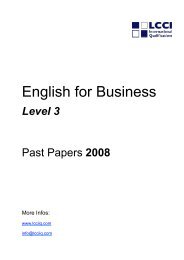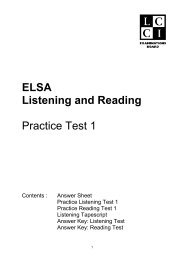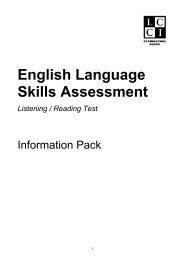English For Business Level 3 Infopack - LCCI
English For Business Level 3 Infopack - LCCI
English For Business Level 3 Infopack - LCCI
You also want an ePaper? Increase the reach of your titles
YUMPU automatically turns print PDFs into web optimized ePapers that Google loves.
Examination Syllabus<br />
The candidate must ensure:<br />
4.9 That, in transferring the data, an appropriate format and tone are adopted<br />
4.10 That the message received in one form is transmitted in the required form. This may involve:<br />
4.10.1 reducing lengthy messages without loss of information<br />
4.10.2 expanding fragmentary messages<br />
4.10.3 completing inadequate messages<br />
4.10.4 selecting from redundant messages<br />
5 Linguistic competence (structures)<br />
Candidates must be able to use:<br />
5.1 Subordinate clauses (eg The report, as you said, was ...)<br />
5.2 Introductory adverbials expressing:<br />
5.2.1 attitude (eg frankly, honestly)<br />
5.2.2 declarative sentences (eg naturally, obviously)<br />
5.2.3 defining a viewpoint (eg theoretically speaking)<br />
5.2.4 argument structure (eg nevertheless, otherwise)<br />
5.3 The anaphoric use of pronouns; using pronouns, possessives, proadverbials there, then and the<br />
verb do when referring back (eg His manager lived there long before he did)<br />
6 Linguistic competence (concepts)<br />
Candidates must be able to express:<br />
6.1 (Non) existence (eg to destroy, to create, to occur, to discover)<br />
6.2 Location:<br />
6.2.1 nouns (eg place/position)<br />
6.2.2 verbs (eg to be situated/arranged)<br />
6.2.3 relative position – preposition (eg at the back of), adverbs below, at the side<br />
6.3 Distance (eg remote)<br />
6.4 Motion (eg to flow, to come along)<br />
6.5 Direction:<br />
6.5.1 destination (eg is there a direct route?)<br />
6.5.2 adverbs (eg backwards/clockwise)<br />
6.5.3 prepositions (eg up, down, towards)<br />
6.6 Arrangement (eg pattern, set)<br />
6.7 Dimension:<br />
6.7.1 size (eg enormous/tiny)<br />
6.7.2 verbs (eg to become, to get bigger)<br />
6.7.3 weight (eg load, weigh)<br />
6.7.4 volume (eg content, to contain)<br />
6.7.5 nouns (eg depth, length)<br />
6.8 Time:<br />
6.8.1 indications (eg whenever)<br />
6.8.2 duration:<br />
- prepositions (eg throughout)<br />
- verbs (eg to continue)<br />
- adverbs (eg always, for good)<br />
6.8.3 sequence (eg next, later on)<br />
6.8.4 simultaneousness (eg meanwhile, while + sub-clause)<br />
6.8.5 future reference (eg soon)<br />
6.8.6 past reference (eg recent(ly))<br />
6.8.7 speed (eg rapid(ly))<br />
6.8.8 frequency (eg occasional(ly),weekly)<br />
6.8.9 continuity (eg to carry on)<br />
6.8.10 performance/intermittence (eg permanent(ly), sporadic(ally))<br />
6.8.11 commencement/end (eg to begin, finish)<br />
6.9 Number:<br />
6.9.1 fractions (eg It’s half of what we ordered)<br />
6.9.2 minus/plus (eg It’s minus 5 degrees)<br />
6.9.3 negative/positive<br />
6.10 Quantity:<br />
6.10.1 determiners (eg less, least)<br />
6.10.2 percent/sum/total<br />
6.10.3 to add/to subtract/to multiply/ to divide<br />
6.11 Degree (eg somewhat more expensive /hardly a bargain)<br />
21<br />
EFB <strong>Level</strong> 3



